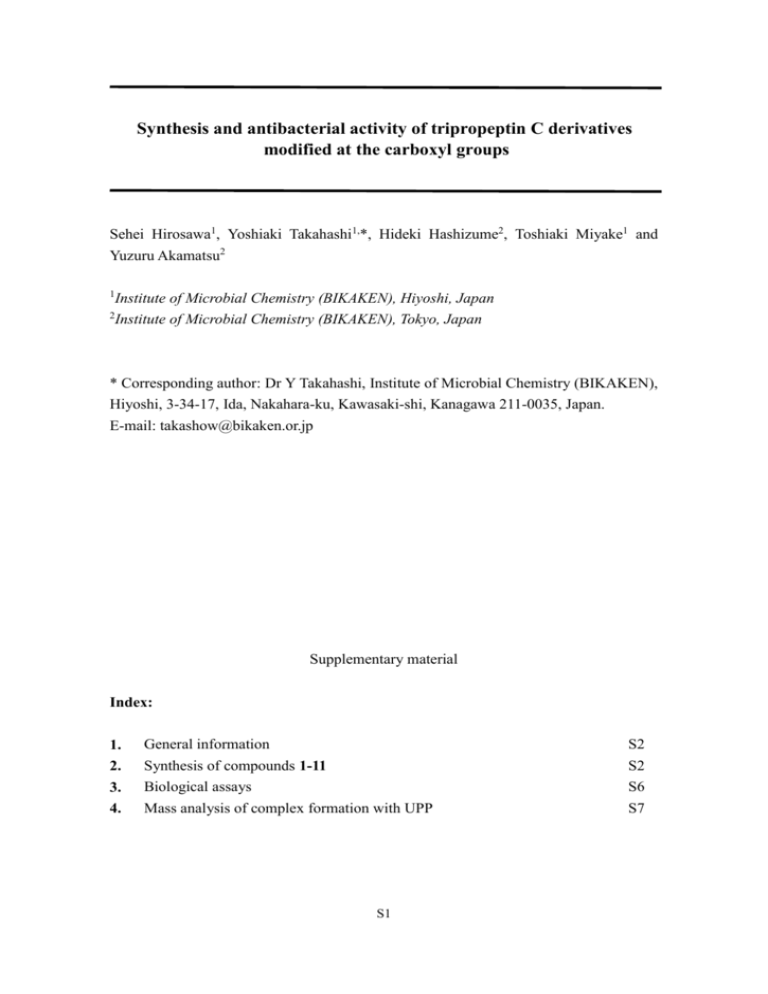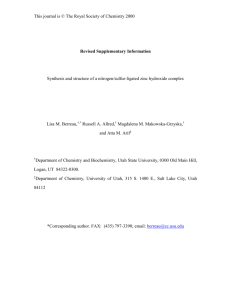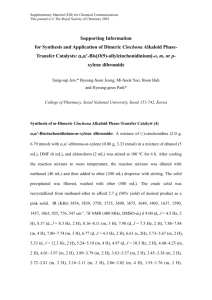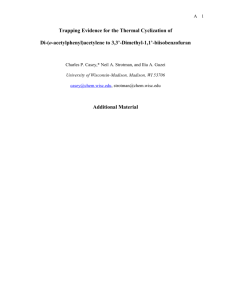Synthesis and antibacterial activity of tripropeptin C
advertisement

Synthesis and antibacterial activity of tripropeptin C derivatives modified at the carboxyl groups Sehei Hirosawa1, Yoshiaki Takahashi1,*, Hideki Hashizume2, Toshiaki Miyake1 and Yuzuru Akamatsu2 1 Institute of Microbial Chemistry (BIKAKEN), Hiyoshi, Japan 2 Institute of Microbial Chemistry (BIKAKEN), Tokyo, Japan * Corresponding author: Dr Y Takahashi, Institute of Microbial Chemistry (BIKAKEN), Hiyoshi, 3-34-17, Ida, Nakahara-ku, Kawasaki-shi, Kanagawa 211-0035, Japan. E-mail: takashow@bikaken.or.jp Supplementary material Index: 1. 2. 3. 4. General information Synthesis of compounds 1-11 Biological assays Mass analysis of complex formation with UPP S1 S2 S2 S6 S7 1. General information 1 H NMR spectra were recorded on an AVANCE 500 spectrometer (500 MHz) or AVANCEIII400 HD spectrometer (400 MHz, Bruker Biospin, Rheinstetten, Germany) at 300K. The chemical shifts () were measured downfield from tetramethylsilane, which was used as an internal standard, and were confirmed, when necessary, by shift-correlated 2D spectra. The mass spectra were recorded on a LTQ XL electrospray ionization (ESI) spectrometer (Thermo Fisher Scientific, San Jose, CA, USA) and/or a JMS-T100LC (ESI) spectrometer (JEOL JMS-T100LC, Tokyo, Japan). TLC was performed on a Kieselgel 60 F254 (Merck, Darmstadt, Germany), and column chromatography was carried out on Wakogel C-200 (Wako Pure Chemical Industries, Ltd., Osaka, Japan). 2. Synthesis of compounds 1–11 Tripropeptin C 16-methyl ester (1) and tripropeptin C 4-methyl ester (2). To a solution of tripropeptin C (92 mg, 0.080 mmol) in methanol (8 ml) was added trimethylsilyldiazomethane (13.7 mg, 0.12 mmol) in hexane (0.2 ml) and the solution was kept for 1 h at room temperature. A further charge of trimethylsilyldiazomethane (13.7 mg, 0.12 mmol) in hexane (0.2 ml) was then added and the solution kept likewise for further 1 h. TLC (CHCl3-MeOH-H2O, 10:5:1) of the solution showed four spots at RF=0.55 (1), 0.35, 0.25 and 0.15 (2) (cf. TPPC: RF= 0.10). Concentration gave a residue, which was purified by chromatography (CHCl3-MeOH-H2O, 10:5:1) to give 1 (14.1 mg, 15%) and 2 (26.3 mg, 28%) as colorless solids. 1: 1H NMR (500 MHz, DMSO-d6): 0.84 (6H, d, J = 6.5 Hz), 3.68 (3H, s, OCH3), 3.95 (1H, m), 4.00 (1H, br s), 4.40 (1H, d, J = 6 Hz), 4.50 (1H, d, J = 6.5 Hz), 4.81 (1H, dd, J = 3.5 and 10 Hz), 4.88 (1H, br s, OH), 4.95 (1H, d, J = 10 Hz, OH), 6.61 (1H, d, J = 6 Hz), 7.37 (1H, d, J = 5.5 Hz, NH), 7.55 (1H, d, J = 9.5 Hz, NH), 7.95 (1H, d, J = 10 Hz, NH), 8.22 (1H, d, J = 9.5 Hz, NH), 8.92 (1H, d, J = 9 Hz, NH), 8.99 (1H, br s, NH). ESI-MS: m/z calcd. for C52H85N11O19 1167.6; found [M+H]+ 1168.9. 2: 1H NMR (500 MHz, DMSO-d6): 0.84 (6H, d, J = 6.5 Hz), 0.98 (3H, d, J = 6 Hz), 2.34 (1H, d, J = 13 Hz), 2.60 (1H, t, J = 13 Hz), 3.53 (3H, s, OCH3), 4.23 (1H, d, J = 8 Hz), 4.38 (1H, br s, OH), 4.80 (1H, d, J = 7.5 Hz), 4.95 (1H, t, J = 5.5 Hz, OH), 5.66 (1H, d, J = 7.5 Hz, OH), 6.71 (1H, d, J = 7 Hz, NH), 7.18 (1H, d, J = 6.5 Hz, NH), 7.99 (1H, d, J = 10 Hz, NH), 8.21 (1H, d, J = 9.5 Hz, NH), 8.55 (1H, d, J = 8.5 Hz, NH), 8.80 (1H, br s, NH). ESI-MS: m/z calcd. for C52H85N11O19 1167.6; found [M+H]+ 1168.9. S2 Tripropeptin C 16-diphenylmethyl ester (3) and tripropeptin C 4-diphenymethyl ester (4). To a solution of tripropeptin C (115 mg, 0.10 mmol) in methanol (5 ml) was added diphenyldiazomethane (60 mg, 0.31 mmol) and the solution was kept for 2 h at room temperature. Concentration gave a residue, which was washed with diethyl ether and chromatographed (CHCl3-MeOH-H2O, 60:20:3) to give 3 (32.9 mg, 25%) and 4 (23.6 mg, 18%) as colorless solids, together with recovered tripropeptin C (58 mg). 3: 1H NMR (500 MHz, DMSO-d6): 0.84 (6H, d, J = 6.5 Hz), 0.97 (3H, d, J = 6 Hz), 2.37 (1H, slightly br d, J = ~13 Hz), 2.84 (1H, dd, J = 11.5 and 15 Hz), 3.17 (1H, t, J = 9 Hz), 4.24 (1H, dt, J = 4, 10 and 10 Hz), 4.56 (1H, dd, J = 4.5 and 6 Hz), 4.85 (1H, dd, J = 4 and 9 Hz), 4.90 (1H, m), 5.12 (1H, d, J = 4 Hz, OH), 6.24 (1H, d, J = 6 Hz, OH), 6.71 (1H, s, Ph2CH), 7.68 (1H, t, J = ~5 Hz, NH), 7.90 (1H, d, J = 9 Hz, NH), 8.10 (1H, d, J = 9 Hz, NH), 8.15 (1H, d, J = 9 Hz, NH), 8. 61(1H, d, J = 8.5 Hz, NH), 10.89 (1H, d, J = 9 Hz, NH). ESI-MS: m/z calcd. for C64H93N11O19 1319.7; found [M+Na]+ 1342.7. 4: 1H NMR (500 MHz, DMSO-d6): 0.84 (6H, d, J = 6.5 Hz), 0.99 (3H, d, J = 6 Hz), 2.29 (1H, d, J = 13.5 Hz), 2.54 (1H, t, J = 13.5 Hz), 4.95 (1H, d, J = ~2 Hz, OH), 5.11 (1H, m), 6.21 (1H, d, J = 7 Hz, OH), 6.90 (1H, s, Ph2CH), 7.07 (1H, d, J = 7.5 Hz, NH), 7.75 (1H, d, J = 9 Hz, NH), 8.05 (1H, d, J = 9 Hz, NH), 8.26 (1H, d, J = 8.5 Hz, NH), 8.55 (1H, br s, NH). ESI-MS: m/z calcd. for C64H93N11O19 1319.7; found [M+Na]+ 1342.7. Tripropeptin C 4, 16-bis-methyl ester (5). To a solution of tripropeptin C (115 mg, 0.10 mmol) in methanol (2.5 ml) was added p-toluenesulfonic acid (43.3 mg, 0.25 mmol) and the solution was kept for 0.5 h at room temperature. The reaction solution was concentrated to a small volume and diethyl ether was added. The resulting precipitate was washed thoroughly with diethyl ether to give a solid of tripropeptin C bis-p-toluenesulfonate. To a solution of this solid in methanol (6 ml) was added trimethylsilyldiazomethane (171 mg, 1.50 mmol) in hexane (2.5 ml) and the resulting solution was kept for 0.5 h at room temperature. Concentration gave a residue, which was washed with diethyl ether and chromatographed (CHCl3-MeOH-H2O, 60:20:3) to give a colorless solid of 5 (110 mg, 82%) as the p-toluenesulfonic acid salt. 5 p-toluenesulfonate: 1H NMR (500 MHz, DMSO-d6): 0.84 (6H, d, J = 6.5 Hz), 0.98 (3H, d, J = 6 Hz), 2.29 (3H, s, CH3C6H4SO2), 3.58 (3H, s, OCH3), 3.60 (3H, s, OCH3), S3 4.15 (1H, s), 4.52 (1H, d, J =5 Hz, OH), 4.92 (1H, t, J =6 Hz, OH), 5.13 (1H, d, J =3 Hz, OH), 5.70 (1H, d, J =7.5 Hz, OH), 6.07 (1H, d, J =5.5 Hz, OH), 7.11 & 7.47 (each 2H, d, J =8 Hz, CH3C6H4SO2), 7.84 (1H, d, J =9.5 Hz, NH), 8.03 (1H, d, J =9 Hz, NH), 8.83 (1H, d, J =9 Hz, NH). ESI-MS: m/z calcd. for C53H87N11O19 1181.6; found [M+p-TsOH+Na]+ 1353.64. Tripropeptin C 4, 16-bis-diphenylmethyl ester (6). To a solution of tripropeptin C (115 mg, 0.10 mmol) in methanol (3 ml) was added p-toluenesulfonic acid (43.0 mg, 0.25 mmol) and the solution was kept for 0.5 h at room temperature. The reaction solution was concentrated to a small volume and diethyl ether was added. The resulting precipitate was thoroughly washed with diethyl ether to give a solid of tripropeptin C bis-p-toluenesulfonate. To a solution of this solid in methanol (3 ml) was added diphenyldiazomethane (348 mg, 1.79 mmol) and the solution was kept for 1 h at room temperature. Concentration gave a residue, which was washed with diethyl ether and chromatographed (CHCl3-MeOH-H2O, 60:20:3) to give a colorless solid of 6 (149 mg, 90%) as the p-toluenesulfonic acid salt. 6 p-toluenesulfonate: 1H NMR (500 MHz, DMSO-d6): 0.84 (6H, d, J = 6.5 Hz), 1.02 (3H, d, J = 6 Hz), 2.29 (3H, s, CH3C6H4SO2), 6.01 (1H, d, J = 7 Hz, OH), 6.07 (1H, d, J = 6 Hz, OH), 6.73 (1H, s, Ph2CH), 6.82 (1H, s, Ph2CH). ESI-MS: m/z calcd. for C77H103N11O19 1485.7; found [M+p-TsOH+Na]+ 1680.8. Tripropeptin C 4-(2-carboxy)ethyl amide (7). To a solution of 3 (158 mg, 0.12 mmol) in methanol (4 ml) was added p-toluenesulfonic acid (20.7 mg, 0.12 mmol) and the solution was stirred for 1 h at room temperature. Concentration gave a residue, which was washed with diethyl ether to give 3 p-toluenesulfonate. A mixture of 3 p-toluenesulfonate, -alanine diphenylmethylester p-toluenesulfonate (205 mg, 0.48 mmol), N-methylmorpholine (36.4 mg, 0.36 mmol), 1-hydroxybenzotriazole (24.3 mg, 0.18 mmol) and N, N-dicyclohexylcarbodiimide (37.1 mg, 0.18 mmol) in N, N-dimethylformamide (3.6 ml) was stirred overnight at room temperature. Concentration gave a residue, which was washed with diethyl ether and chromatographed on a Sepadex LH 20 column (MeOH) to give a solid of 4-amide of 3. To a solution of the solid in chloroform (2.5 ml) was added trifluoroacetic acid (1.2 ml) and anisole (0.6 ml) and the solution was kept for 1 h at room temperature. Concentration gave a residue, which was chromatographed (CHCl3-MeOH-H2O, S4 10:5:1) to give a colorless solid of 7 (93.6 mg, 56%) as the p-toluenesulfonic acid salt. H NMR (400 MHz, DMSO-d6): 0.84 (6H, d, J = 6.5 Hz), 2.29 (3H, s, CH3C6H4SO2), 4.79 (1H, d, J = 8 Hz), 5.08 (1H, br s), 7.82 (1H, d, J =9 Hz), 8.04 (1H, d, J =8 Hz), 1 8.27 (1H, d, J =9 Hz). ESI-MS: m/z calcd. for C54H88N12O20 1224.6; found [M–H]– 1223.7. Tripropeptin C 16-(2-carboxy)ethyl amide (8). This compound was prepared from 4 following the procedure in preparation of 7 in 58% yield. 1H NMR (500 MHz, DMSO-d6): 0.85 (6H, d, J = 6.5 Hz), 0.97 (3H, d, J = 6 Hz), 2.38 (1H, d, J =13 Hz), 2.84 (1H, t, J =13 Hz), 4.72 (1H, dd, J = 5.5 and 9 Hz), 4.84 (1H, d, J = 8 Hz), 4.90 (1H, br s), 5.08 (1H, d, J =3 Hz), 6.20 (1H, d, J =6 Hz), 7.72 (1H, t, J =5 Hz), 8.13 (1H, d, J = 9 Hz), 8.51 (1H, d, J =8 Hz). ESI-MS: m/z calcd. for C54H88N12O20 1224.6; found [M–H]– 1223.6. Tripropeptin C 4-[(S)-4-carboxy-3-hydroxy]butyl amide (9). This compound was prepared from 3 and (S)-5-amino-2-hydroxypentanoic acid diphenylmethylester p-toluenesulfonate following the procedure in preparation of 7 in 61% yield. 1H NMR (500 MHz, DMSO-d6): 0.84 (6H, d, J = 6.5 Hz), 0.99 (3H, d, J = 6 Hz). ESI-MS: m/z calcd. for C56H92N12O21 1268.7; found [M–H]– 1267.6. Tripropeptin C 16-[(S)-4-carboxy-3-hydroxy]butyl amide (10). This compound was prepared from 4 and (S)-5-amino-2-hydroxypentanoic acid diphenylmethylester p-toluenesulfonate following the procedure in preparation of 7 in 71% yield. 1H NMR (500 MHz, DMSO-d6): 0.85 (6H, d, J = 6.5 Hz), 0.97 (3H, d, J = 6 Hz), 2.37 (1H, d, J =13 Hz), 2.82 (1H, t, J =13 Hz), 4.85 (1H, d, J = 8 Hz), 4.91 (1H, br s), 5.09 (1H, s), 6.09 (1H, br s), 8.10 (1H, d, J = 8 Hz), 8.48 (1H, br s). ESI-MS: m/z calcd. for C56H92N12O21 1268.7; found [M–H]– 1267.6. Tripropeptin C 4-(4-amino)butyl amide (11). This compound was prepared from 3 and t-butoxycarbonylaminobutylamine following the procedure in preparation of 7 in 52% yield. 1H NMR (500 MHz, DMSO-d6): 0.84 (6H, d, J = 6.5 Hz), 5.03 (1H, br s), 5.15 (1H, br s) 8.85 (1H, br s). ESI-MS: m/z calcd. S5 for C55H93N13O18 1223.7; found [M+H]+ 1224.5. 3. Biological assays The minimum inhibitory concentrations (MICs) were determined by the serial agar dilution method using Mueller-Hinton agar (Difco) for Staphylococcus aureus.1 Ref.1 Japan Society of Chemotherapy. Method of MIC determination. Chemotherapy 38, 102-105 (1990) (in Japanese). S6 4. Mass analysis of complex formation with UPP TPPC or bis-methyl ester 5 was mixed with undecaprenyl pyrophosphate (UPP) in 50% aqueous MeOH, and the resulting mixture was subjected to mass spectroscopic analysis. The mass spectra were recorded using a JMS-T100LC (ESI) spectrometer (JEOL JMS-T100LC, Tokyo, Japan). For the TPPC, complex formation with UPP was detected at 2120 Da, whereas the complex formed between the bis-methyl ester 5 and UPP was not observed [refer to (A)-(D) of Figure S1]. Abbreviations: UP, undecaprenyl monophosphate; UPP, undecaprenyl pyrophosphate. S7








